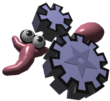- Timestamp:
- 08/24/15 19:57:12 (10 years ago)
- File:
-
- 1 edited
Legend:
- Unmodified
- Added
- Removed
-
experiments/frams/foraminifera/data/scripts/foraminifera.show
r407 r422 2 2 name:Reproduction of benthic foraminifera 3 3 info:~ 4 Foraminifers are shown as green balls. Nutrients are tiny white boxes. 5 Foraminifers move towards nearest nutrients and try to accumulate a sufficient amount of energy to reproduce. 6 Haploid and diploid generations alternate. Diploid foraminifers have orange marks. 4 There are two species of Foraminiera: longitudal and coiled. First chamber of the longitudal species has 5 orange marks. Haploid and diploid generations alternate in both species. All chambers of the haploid generation 6 have the same size. In the diploid generation subsequent chambers are bigger than their predecessors. 7 Nutrients are green disks. Foraminifers move towards nearest nutrients and try to accumulate a sufficient 8 amount of energy to reproduce. 9 7 10 More information at www.framsticks.com/foraminifera 8 11 ~ … … 16 19 GLDisplay.minfps = 10; 17 20 } 18 19 function ShowParams_minimalVolume_set() 21 function ShowParams_nutrientPop_set() 20 22 { 21 switch (ShowParams. minimalVolume)23 switch (ShowParams.nutrientPop) 22 24 { 23 25 case 0: 24 ExpParams.v_min_h = 300; 25 ExpParams.v_min_d = 300; 26 ExpParams.nutrientPop = 5; 26 27 break; 27 28 case 1: 28 ExpParams.v_min_h = 150; 29 ExpParams.v_min_d = 500; 30 break; 31 } 32 } 33 34 function ShowParams_offspingNumber_set() 35 { 36 switch (ShowParams.offspingNumber) 37 { 38 case 0: 39 ExpParams.ofnumh = 300; 40 ExpParams.ofnumd = 300; 41 break; 42 case 1: 43 ExpParams.ofnumh = 150; 44 ExpParams.ofnumd = 500; 45 break; 46 } 47 } 48 49 function ShowParams_populationSize_set() 50 { 51 switch (ShowParams.populationSize) 52 { 53 case 0: 54 ExpParams.psize = 5; 55 break; 56 case 1: 57 ExpParams.psize = 10; 29 ExpParams.nutrientPop = 10; 58 30 break; 59 31 case 2: 60 ExpParams.psize = 15; 61 break; 62 case 3: 63 ExpParams.psize = 20; 32 ExpParams.nutrientPop = 15; 64 33 break; 65 34 } … … 71 40 { 72 41 case 0: 73 ExpParams.feedrate = 0. 5;42 ExpParams.feedrate = 0.001; 74 43 break; 75 44 case 1: 76 ExpParams.feedrate = 0. 7;45 ExpParams.feedrate = 0.0025; 77 46 break; 78 47 case 2: 79 ExpParams.feedrate = 0.9; 48 ExpParams.feedrate = 0.004; 49 break; 50 } 51 } 52 53 function ShowParams_feedTrans_set() 54 { 55 switch (ShowParams.feedTrans) 56 { 57 case 0: 58 ExpParams.feedtrans = 0.01; 59 break; 60 case 1: 61 ExpParams.feedtrans = 0.05; 62 break; 63 case 2: 64 ExpParams.feedtrans = 0.1; 65 break; 66 } 67 } 68 69 function ShowParams_nutrientEnerg_set() 70 { 71 switch (ShowParams.nutrientEnerg) 72 { 73 case 0: 74 ExpParams.energy_nut = 0.5; 75 break; 76 case 1: 77 ExpParams.energy_nut = 1.5; 78 break; 79 case 2: 80 ExpParams.energy_nut = 3.0; 81 break; 82 } 83 } 84 85 function ShowParams_stress_set() 86 { 87 switch (ShowParams.stress) 88 { 89 case 0: 90 ExpParams.stress = 0; 91 break; 92 case 1: 93 ExpParams.stress = 1; 80 94 break; 81 95 } … … 84 98 ~ 85 99 86 87 100 prop: 88 id:minimalVolume 89 name:Min reproduction energy haploid/diploid 90 type:f 0 1 ~300 / 300~150 / 500 91 92 prop: 93 id:populationSize 94 name:Initial population size 95 type:d 0 3 ~5~10~15~20 96 97 prop: 98 id:offspingNumber 99 name:Number of offspring haploi/diploid 100 type:d 0 2 ~20 / 4~10 / 5 101 id:nutrientPop 102 name:Nutrients amount 103 type:d 0 2 1 ~5~10~15 101 104 102 105 prop: 103 106 id:feedRate 104 107 name:Feeding rate 105 type:d 0 2 ~50~70~90 108 type:d 0 2 1 ~1~2~3 109 110 prop: 111 id:feedTrans 112 name:Energy transfer 113 type:d 0 2 1 ~0.01~0.05~0.1 114 115 prop: 116 id:nutrientEnerg 117 name:Nutrient energy 118 type:d 0 2 1 ~0.5~1.5~3 119 120 prop: 121 id:stress 122 name:Stress 123 type:d 0 1 1
Note: See TracChangeset
for help on using the changeset viewer.
